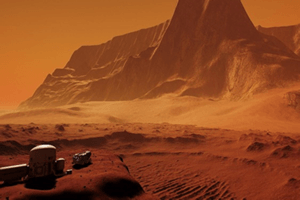By LEO SOPICKI
There’s an old expression for when something is not difficult: “It doesn’t take a rocket scientist.” But when it comes to creating a virtual reality experience of Mars, it does take a rocket scientist. Five of them, actually. “Mars Experience VR,” a presentation at South by Southwest (SXSW), the annual film, music and technology festival in Austin, Texas, explained the creation of a virtual Mars which can be explored by users of VR technology.
Realistic Martian World
NASA, NVIDIA and MIT’s Space Systems Laboratory helped FusionVR create a realistic Martian world called The Mars 2030 Experience. This is not just a video game simulation, but a project which has maintained scientific accuracy and aims to demonstrate where we are in moving towards mankind’s next frontier. Coding was done by members of Bioshock Infinite’s technical team, using NVIDIA’s latest VR technologies and cutting-edge VR audio by Source Sound.
Mars Experience VR Panel
Listening to the Mars Experience VR panel, I thought at first this was a lot of effort to go through for a VR experience, but along the way I began to appreciate and discover the more serious purpose of this effort. The Mars Experience VR panel consisted of five heavyweights in technology and space flight.
Julian Reyes, VR Producer from Fusion Media Network, led off the discussion with praise for everyone on the panel. He explained that what was being produced was not just a video game, but a highly detailed and accurate simulation of the surface of Mars. The virtual Mars is based on data and photographs from the Mars Rover and a European satellite orbiting the red planet. He explained that this project was part of a larger effort, including the work of panelist Sydney Do, to determine the feasibility of establishing human habitation on Mars.
Do, a PhD candidate in Aeronautics & Astronautics at MIT, said that we are now years ahead with state-of-the-art research on how people can live on Mars than we were when we were uncertain what would happen to men who traveled to the Moon.
Show People What Is Possible
Do described the virtual Mars project as similar to the Man in Space documentary produced by Walt Disney in the 1950s. “Wernher von Braun, the leading rocket scientist of the day, worked with Walt Disney to show people what was possible and create support for the idea,” he said. “Virtual Mars will make anyone feel like they are an astronaut on Mars and get them thinking about the possibilities.” The original Disneyland episode which featured Man in Space is linked at the bottom of this article.
Patrick Troutman, Senior Systems Engineer at NASA Langley Research Center, talked about the problems that must be solved to expand the human presence in the universe. “It is really hard, because we’ve never sent people on a three-year mission [to space],” he said. “We need to solve human problems before we can launch a Mars campaign.”
“Questions that must be answered,” Troutman explained, “include: Can humans live in space for a thousand days or more? And can technological systems go months and years between use?” Troutman suggested that several steps would be needed to answer these questions. Humans would need to live in deep space, just beyond the gravity well of the Earth and the Moon, for extended periods to determine the impact on their bodies. This would need to be followed by a Mars orbit. Then we would need to see if we could land something on Mars and get it off again. Fully reusable spacecraft, such as the Phobos Exploration Vehicle, would also be needed.
Seven Times the Horsepower Required for a PC Game
Zvi Greenstein, General Manager of GeForce Desktop at NVIDIA, added that this project was more complicated than anything they had ever worked on before. VR applications for gaming, sports, and education were easy to get photos for, and simulating something for those applications was not a problem. For this project though, it was different. “We worked with our Fusion Media partners to create with the highest degree of accuracy,” he said. “All the equipment shown is from catalogs from NASA. We did lots of data acquisition and research and used only the greatest graphics technology. We did not compromise. The high end versions of this will run at 90 frames per second. This VR takes seven times the horsepower to run than is needed for a PC game.”
Justin Sonnekalb, the projects Technical Designer, explained that the support from NVIDIA and the Mars Rover data from NASA allowed his team to create a simulation in which each pixel on the screen represents 30 centimeters on Mars. Showing the terrain at a distance accurately was more challenging, but doable. “There are two satellites continuously scanning the surface of Mars,” he explained. “After two passes we are able to infer stereoscopically the elevation and assemble terrain models. We also get data from the European Space Agency which is mapping the surface at 50 meters per pixel.”
Sonnekalb said that other challenges were color and physics. “No one can really tell us what color anything is, because only about 50 percent of the images you see are balanced the way they would look on Mars,” he said. “The Martian sky is golden at noon and sunsets are blue. Physics is challenging as well, because all the software packages we have from the gaming world make things behave like they would on Earth. The gravity is not the same so we have to change the software to deal with the things that the Mars Rover can do on Mars.”
Demos of the project should be available free of charge online in April for the Oculus Rift, Google Cardboard, and Samsung VR Gear via Valve’s Steam marketplace and on Fusion.net. If you have an iPhone or Android device, demos will be available in their respective stores and a streaming version will be available on Twitch.tv.











Share This
Share this post with your friends!